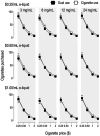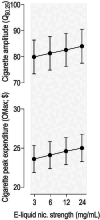Does e-cigarette nicotine strength influence substitution for combustible cigarettes?
- PMID: 41055893
- PMCID: PMC12503084
- DOI: 10.1002/jeab.70056
Does e-cigarette nicotine strength influence substitution for combustible cigarettes?
Abstract
Using the Experimental Tobacco Marketplace, we examined the effects of e-liquid freebase nicotine strength (3-24 mg/mL) and e-liquid price (US$0.25-$1.00/mL) on behavioral economic substitution for cigarettes in dual cigarette/e-cigarette (n = 41) and exclusive cigarette (n = 40) users. Subjective effects of nicotine strength were also examined. All nicotine strengths served as a substitute for combustible cigarettes, with greater substitution observed in dual users. When analyzing e-liquid volume purchased (mL), nicotine strength did not influence substitution; however, when analyzing e-liquid nicotine purchased (mg), degree of substitution increased as a function of nicotine strength. Additionally, higher nicotine strengths reduced the volume and probability of e-liquid purchasing, increased cigarette demand, and produced less favorable subjective effects than lower strengths. Increasing e-liquid price reduced e-liquid purchasing and did not influence substitution. We conclude that nicotine strength does not robustly affect the degree to which e-liquid substitutes for cigarettes, as no effect was observed in analysis of the unit of purchase most relevant to real-world sales (volume). Instead, high-strength nicotine potentially reduces the appeal and probability of purchasing e-liquid. Future work should examine these effects in nicotine salt-based e-liquids compared with freebase nicotine (used here) and in choice contexts with concurrent access to different nicotine strengths.
Keywords: cigarettes; demand; e‐cigarettes; nicotine; substitution.
© 2025 The Author(s). Journal of the Experimental Analysis of Behavior published by Wiley Periodicals LLC on behalf of Society for the Experimental Analysis of Behavior.
Conflict of interest statement
The authors do not declare any conflicts of interest with respect to the authorship or publication of this article.
Figures






References
-
- Ali, F. R. M. , Schillo, B. , Crane, E. , Seaman, E. L. , & King, B. A. (2023). Evaluation of statewide restrictions on e‐cigarette nicotine strength‐United States, 2017–2022. Addiction, 118(9), 1701–1709. - PubMed
-
- Ali, F. R. M. , Seaman, E. L. , Diaz, M. C. , Ajose, J. , & King, B. A. (2024). Trends in unit sales of cooling flavoured e‐cigarettes, USA, 2017–2021. Tobacco Control, 33(2), 147–153. - PubMed
-
- Barrett, S. T. , & Odum, A. L. (2011). The effects of repeated exposure on the reward‐enhancing effects of nicotine. Behavioural Pharmacology, 22(4), 283–290. - PubMed
MeSH terms
Substances
Grants and funding
LinkOut - more resources
Full Text Sources
Medical

